ARTICLE 9 ASSOCIATED ENTERPRISES 1. Where an enterprise of a Contracting State participates directly or indirectly in the management, control or capital of an enterprise of the other Contracting State, or the same persons participate directly or indirectly in the management, control or capital of an enterprise of a Contracting State and an enterprise of the other Contracting State, and in either case conditions are made or imposed between the two enterprises in their commercial or financial relations which differ from those which would be made between independent enterprises, then any profits which would, but for those conditions, have accrued to one of the enterprises, but, by reason of those conditions, have not so accrued, may be included in the profits of that enterprise and taxed accordingly. 2. Where a Contracting State includes in the profits of an enterprise of that State – and taxes accordingly – profits on which an enterprise of the other Contracting State has been charged to tax in that other State and the profits so included are profits which would have accrued to the enterprise of the first mentioned State if the conditions made between the two enterprises had been those which would have been made between independent enterprises, then that other State shall make an appropriate adjustment to the amount of the tax charged therein on those profits. In determining such adjustment, due regard shall be had to the other provisions of this Convention and the competent authorities of the Contracting States shall if necessary, consult each other. COMMENTARY ON ARTICLE 9 CONCERNING THE TAXATION OF ASSOCIATED ENTERPRISES 1. This Article deals with adjustments to profits that may be made for tax purposes where transactions have been entered into between associated enterprises (parent and subsidiary companies and companies under common control) on other than arm’s length terms. The Committee has spent considerable time and effort (and continues to do so) examining the conditions for the application of this Article, its consequences and the various methodologies which may be applied to adjust profits where transactions have been entered into on other than arm’s length terms. Its conclusions are set out in the report entitled Transfer Pricing Guidelines for Multinational Enterprises and Tax Administrations,’ which is periodically updated to reflect the progress of the work of the Committee in this area. That report represents internationally agreed principles and provides guidelines for the application of the arm’s length principle of which the Article is the authoritative statement. Paragraph 1 2. This paragraph provides that the taxation authorities of a Contracting State may, for the purpose of calculating tax liabilities of associated enterprises, re-write the accounts of the enterprises if, as a result of the special relations between the enterprises, the accounts do not show the true taxable profits arising in that State. It is evidently appropriate that adjustment should be sanctioned in such circumstances. The provisions of this paragraph apply only if special conditions have been made or imposed between the two enterprises. No re-writing of the accounts of associated enterprises is authorised if the transactions between such enterprises have taken place on normal open market commercial terms (on an arm’s length basis). 3. As discussed in the Committee on Fiscal Affairs’ Report on “Thin Capitalisation” there is an interplay between tax treaties and domestic rules on thin capitalisation relevant to the scope of the Article. The Committee considers that: a) the Article does not prevent the application of national rules on thin capitalisation insofar as their effect is to assimilate the profits of the borrower to an amount corresponding to the profits which would have accrued in an arm’s length situation; b) the Article is relevant not only in determining whether the rate of interest provided for in a loan contract is an arm’s length rate, but also whether a prima facie loan can be regarded as a loan or should be regarded as some other kind of payment, in particular a contribution to equity capital; c) the application of rules designed to deal with thin capitalisation should normally not have the effect of increasing the taxable profits of the relevant domestic enterprise to more than the arm’s length profit, and that this principle should be followed in applying existing tax treaties. 4. The question arises as to whether special procedural rules which some countries have adopted for dealing with transactions between related parties are consistent with the Convention. For instance, it maybe asked whether the reversal of the burden of proof or presumptions of any kind which are sometimes found in domestic laws are consistent with the arm’s length principle. A number of countries interpret the Article in such a way that it by no means bars the adjustment of profits under national law under conditions that differ from those of the Article and that it has the function of raising the arm’s length principle at treaty level. Also, almost all member countries consider that additional information requirements which would be more stringent than the normal requirements, or even a reversal of the burden of proof, would not constitute discrimination within the meaning of Article 24. However, in some cases the application of the national law of some countries may result in adjustments to profits at variance with the principles of the Article. Contracting States are enabled by the Article to deal with such situations by means of corresponding adjustments (see below) and under mutual agreement procedures. Paragraph 2 5. The re-writing of transactions bet ween associated enterprises in the situation envisaged in paragraph 1 may give rise to economic double taxation (taxation of the same income in the hands of different persons), in so far as an enterprise of State A whose profits are revised upwards will be liable to tax on an amount of profit which has already been taxed in the hands of its associated enterprise in State B. Paragraph 2 provides that in these circumstances, State B shall make an appropriate adjustment so as to relieve the double taxation. 6. It
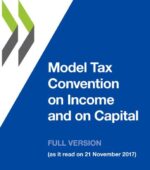
This full version of the OECD Model Tax Convention contains the full text of the Model Tax Convention on Income and on Capital as it read on 21 November 2017, including the Articles, the Commentaries, the non-OECD economies’ positions, the Recommendation of the OECD Council, the historical notes and the full text of a number of background reports adopted after 1977.
Société Générale S.A. had paid for costs from which its subsidiaries had benefited. The costs in question was not deducted by Société Générale in its tax return, but nor had they been considered distribution of profits subject to withholding tax. Following an audit for FY 2008 – 2011 a tax assessment was issued by the tax authorities according to which the hidden distribution of profits from which the subsidiaries benefited should have been subject to withholding tax in France Société Générale held that the advantage granted by the parent company in not recharging costs to the subsidiaries resulted in an increase in the valuation of the subsidiaries. It also argued that the advantages in question were not “hidden” since they were explicitly mentioned in the documents annexed to the tax return By judgment of 11 October 2018, the court of first instance discharged the withholding taxes as regards the absence of re-invoicing of costs incurred on behalf of the subsidiaries located in Mauritania, Burkina Faso and Benin. Judgement of the Court The Administrative Court of Appeal decided partially in favour of the tax authorities and partially in favour of Société Générale. It discharged Société Générale from withholding taxes relating to non-deductible expenses called “remuneration of DeltaCrédit’s managers” and to the costs incurred on behalf of its Moldovan and Georgian subsidiaries based on an interpretation of the articles on dividends in the relevant tax treaties. Excerpts “…Société Générale did not re-invoice “expenses borne by the head office for the subsidiaries”, expressly mentioned as such in the tables No. 2058 A of non-deductible expenses appended to its returns. Société Générale also assumed the costs of “personnel seconded to foreign subsidiaries”, the “remuneration of the managers of [its Russian subsidiary] Deltacrédit”, and, as mentioned in the previous point, “ITEC transfer prices”, which it spontaneously reintegrated into its taxable income, thus acknowledging the non-deductibility of these expenses. These facts reveal that Société Générale has incurred costs that are normally borne by its foreign subsidiaries. As a result, Société Générale is presumed to have made a transfer of profits to a company located outside France, within the meaning of the aforementioned provisions of Article 57 of the General Tax Code. It is therefore incumbent on it to prove that this transfer involved sufficient consideration for it and thus had the character of an act of normal commercial management.” “In this case, with regard to the “expenses borne by the head office for foreign subsidiaries”, the cost of “personnel seconded to foreign subsidiaries”, and “ITEC transfer prices”, the entries in the tables of non-deductible expenses, which do not specify the precise nature of the benefits granted, nor the beneficiary companies, do not in themselves reveal the existence of the gifts granted. On the other hand, the non-accounting mention made by Société Générale, in Table 2058 A of its income tax return, of the benefit granted to its Russian subsidiary DeltaCrédit by paying the remuneration of its managers, reveals both the purpose of the expense and its beneficiary. This advantage could not therefore be considered as a hidden advantage within the meaning of the provisions of Article 111c of the General Tax Code.” “Lastly, even though no financial transfer was made, the costs unduly borne lead to disinvestment for the company which bore them and to distributed income for the company which benefited from them. It follows that, in terms of French tax law, Société Générale is only entitled to argue that the Montreuil Administrative Court was wrong to reject its request for a discharge in respect of the non-deductible charges referred to as “remuneration of DeltaCrédit’s directors” ” Under Article 7 of the Convention between France and the former USSR, applicable to the income at issue: “1. Dividends paid by a resident of a State to a resident of the other State may be taxed in the first State. However, the tax so charged shall not exceed 15 per cent of the gross amount of such dividends. 2. The term “dividends” as used in this Article means income from shares as well as other income which is subjected to the treatment of income from shares by the laws of the State of which the person making the distribution is a resident. “These stipulations do not cover income deemed to be distributed by virtue of the provisions of Article 111 c) of the General Tax Code which is not subject to the same regime as income from shares. Société Générale is therefore entitled to argue that this income was not taxable in France, pursuant to Article 12 of the same agreement, which provides that “income not listed in the preceding articles (…) received by a resident of a State and arising from sources in the other State shall not be taxable in that other State. “.” “Under the terms of Article 13 of the Franco-Mauritanian, Franco-Beninese and Franco-Burkinabe tax treaties: “income from securities and similar income (income from shares, founders’ shares, interest and limited partnership shares, interest from bonds or any other negotiable debt securities) paid by companies (…) having their tax domicile in the territory of one of the Contracting States may be taxed in that State”. These stipulations, which refer only to the income from securities and similar income they list, do not concern income deemed to be distributed within the meaning of Article 111 c) of the General Tax Code. The Minister is therefore not entitled to argue that the first judges wrongly discharged Société Générale from the withholding taxes applied to the benefits granted to its subsidiaries located in Mauritania, Benin and Burkina Faso, which were not taxable in France.” Click here for English translation Click here for other translation
In August 2020, the competent authority of the Belgian tax administration sent a request for information to the Luxembourg tax administration concerning “Lux Service SA” under the tax convention between Luxembourg and Belgium. The requested information regarding “Lux Service SA” was documentation related to the basis for service payments from a related party in Belgium. The tax administration in Luxembourg contacted “Lux Service SA” and requested submission of the information and documents. Lux Service SA did not want to accommodate the request and brought the case to the High Administrative court for an annulment. The tax authorities argued that the appeal should be dismissed as unfounded. The Court dismissed the appeal of “Lux Services SA” and upheld the information injunction issued by the tax administration. The argument that the tax administration had failed to state the reasons for the information injunction was rejected by the Court as unfounded. According to the Court, the information injunction was based on a sufficiently reasoned request from the Belgian tax administration. Click here for English translation Click here for other translation
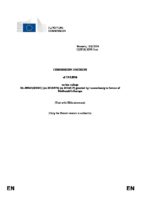
The European Commission found that Luxembourg did not grant illegal State aid to McDonald’s as a consequence of the exemption of income attributed to a US branch. ...it is not established that the Luxembourg tax authorities misapplied the Luxembourg – US double taxation treaty. Therefore, on the basis of the doubts raised in the Opening Decision and taking into account its definition of the reference system, the Commission cannot establish that the contested rulings granted a selective advantage to McD Europe by misapplying the Luxembourg – US double taxation treaty.
A Dutch company, Lender BV, provided loans to an affiliated Russian company on which interest was paid. The Dispute was (1) whether the full amount of interest should be included in the taxable income in the Netherlands, or if part of the “interest payment” was subject to the participation exemption or (2) whether the Netherlands was required to provide relief from double taxation for the Russian dividend tax and, if so, to what amount. The Tax court found it to be a loan and the payments therefor qualified as interest and not dividend. The participation exemption does not apply to interest. In addition, the court ruled that the Russian thin-capitalization rules did not have an effect on the Netherlands through Article 9 of the Convention for the avoidance of double taxation between the Netherlands and Russia. Application of the participation exemption was not an issue. In the opinion of the court, a (re) qualification of interest as a dividend on the basis of the thin capitalization rules in Russia cannot be based on Article 10 of the Treaty. This has not been explicitly included in the text of the treaty and, in the opinion of the court, could not have been the intention of the countries in the absence of a concrete substantiation with facts and / or circumstances. Since the income on the basis of Article 11 of the Treaty cannot be taxed in Russia, the Netherlands is not required to provide relief from double taxation for the Russian dividend tax deducted therefrom. The appeal is unfounded. Click here for other translation
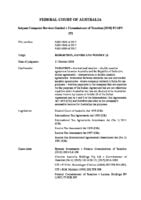
The question in this case was whether payments received by Satyam Computer Services Limited (now Tech Mahindra Ltd) from its Australian clients – that were royalties for the purposes of Article 12 of the tax treaty with India, but not otherwise royalties under Australian tax law – were deemed to be Australian source income by reason of Article 23 of the tax treaty and ss 4 and 5 of the International Tax Agreements Act 1953 and therefore included in the company’s assessable income for Australian tax purposes. The answer provided by the Federal Court confirmed this to be the case. Click here for other translation
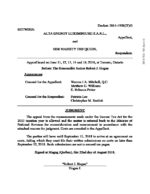
ALTA Energy, a resident of Luxembourg, claimed an exemption from Canadian income tax under Article 13(5) of the Canada-Luxembourg Income Tax Treaty in respect of a large capital gain arising from the sale of shares of ALTA Canada, its wholly-owned Canadian subsidiary. At that time, Alta Canada carried on an unconventional shale oil business in the Duvernay shale oil formation situated in Northern Alberta. Alta Canada was granted the right to explore, drill and extract hydrocarbons from an area of the Duvernay formation designated under licenses granted by the government of Alberta. The Canadian tax authorities denied that the exemption applied and assessed ALTA Energy accordingly. Article 13(5) of the Canada-Luxembourg Tax Treaty is a distributive rule of last application. It applies only in the case where the capital gain is not otherwise taxable under paragraphs (1) to (4) of Article 13 of the Treaty. Article 13(4) is relevant to the outcome of this appeal. Under that provision, Canada has preserved its right to tax capital gains arising from the disposition of shares where the shares derive their value principally from immovable property situated in Canada. However, the application of Article 13(4) is subject to an important exception. Property that would otherwise qualify as Immovable Property is deemed not to be such property in the circumstances where the business of the corporation is carried on in the property (the “Excluded Property” exception). The tax authorities argued that the Shares derived their value principally from Alta Canada’s Working Interest in the Duvernay Formation. The authorities also argued that the capital gain it realized would be taxable under Article 13(4) unless the Court agreed with ALTA’s submission that its full Working Interest is Excluded Property. ALTA Energy appealed the position of the tax authorities and argued the contrary view. According to ALTA, substantially all of ALTA Canada’s Working Interest remained Immovable Property because ALTA Canada drilled in and extracted hydrocarbons from only a small area of the Duvernay Formation that it controlled. The Judgement of the Court The appeal was allowed and the matter referred back to the tax authorities for reconsideration and reassessment.
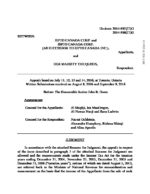
The issue before the court was whether the Canadian revenue service had the ability to issue the second reassessments given the Canadian and US competent authorities subsequently agreed on a MAP settelment. The Tax Court found that a settlement agreed to via the competent authority precluded a subsequent tax-reassessment that attempted to further increase the taxpayer’s income.
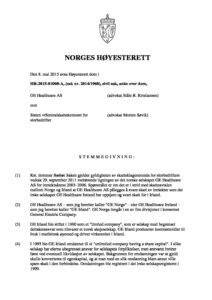
The Supreme Court concluded that the Norwegian taxation of incomes in Ireland were not in violation of the treaty Article 7. 1 and showed that the double taxation which thus arose, in Article 24. 2 gave GE Healthcare AS a tax deduction in Norway equal to the taxes paid by income in Ireland. Such deduction was made by tax decision in the case. GE Healthcare AS was thus protected against the overall tax burden in Norway and Ireland were greater than if the income were only taxed in Norway. There was no reason to limit the taxation of GE Healthcare AS beyond this. Click here for translation

A Ab had in 2009 from its majority shareholder B, based in Luxembourg, received a EUR 15 million inter-company loan. A Ab had in 2009 deducted 1,337,500 euros in interest on the loan. The loan had been granted on the basis that the banks financing A’s operations had demanded that the company acquire additional financing, which in the payment scheme would be a subordinated claim in relation to bank loans, and by its nature a so-called IFRS hybrid, which the IFRS financial statements were treated as equity. The loan was guaranteed. The fixed annual interest rate on the loan was 30 percent. The loan could be paid only on demand by A Ab. The Finnish tax authorities argued that the legal form of the inter-company loan agreed between related parties should be disregarded, and the loan reclassified as equity. Interest on the loan would therefore not be deductible for A Ab. According to the Supreme Administrative Court interest on the loan was tax deductible. The Supreme Administrative Court stated that a reclassification of the loan into equity was not possible under the domestic transfer pricing provision alone. Further, the Supreme Administrative Court noted that it had not been demonstrated or even alleged by the tax authorities that the case was to regarded as tax avoidance. The fact that the OECD Transfer Pricing Guidelines (Sections 1.65, 1.66 and 1.68) could in theory have allowed a reclassification of the legal form of the loan into equity was not relevant because a tax treaty cannot broaden the tax base from that determined under the domestic tax provisions. Consequently, the arm’s length principle included in Article 9 of the tax treaty between Finland and Luxembourg only regarded the arm’s length pricing of the instrument, not the classification of the instrument. Click here for other translation
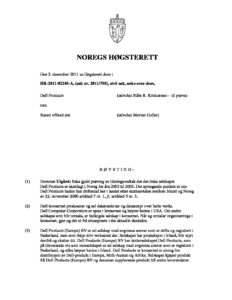
The Irish company Dell Products was taxable in Norway for years 2003-2006. The issue was whether Dell Products had a permenent establishment in Norway, cf. Article 5. 5 in the tax treaty between Ireland and Norway from 2000. Dell Products sold PC’s and equipment by a commission agreement in which the Irish company was Principal and the Norwegian company Dell AS was commissioner. Both the companies are part of the Dell group. Dell AS sold to customers who were large enterprises and the public sector. It was not disputed that the agreement was not legally binding on Dell Products in relation to customers. Dell Products would have a permanent establishment in Norway and may be taxable Norway, if Dell Norway had acted “on behalf of” and had the “authority to conclude contracts on behalf of the” Dell, ref. Tax Treaty Article 5. 5. Unlike the District Court and the Court of Appeal the Supreme Court did not wote in favor of the tax authorities. The wording of the article strongly support that the commissioner must bind the principal in relation to the customer. The article is identical to the OECD Model Convention, and it had the same weight that also the commentary for this support a requirement for judicial bond. Also other legal sources pointed in the same conclusion. When both the wording and other legal sources support this condition, Article 5. 5 cannot lead to an anna result. The Supreme Court came to the conclusion that Dell Products did not have a permanent establishment in Norway. Click here for translation
In this case a US subsidiary, Container Corp, had paid guaranty fees to its foreign parent company Vitro in Mexico. In the US tax return, the fee had been considered analogous to payments for services, and the income was sourced outside the United States and not subject to withholding tax. The IRS held that the guaranty fees were more closely analogized to interest and thus subject to withholding taxes of 30 %. The Tax Court issued an opinion siding with Container Corp. The Commissioner brought the opinion before the US Court of Appeals. The Court of Appeals also found in favor of Container Corp. “To determine what class of income guaranty fees fall within or may be analogized to, the court must look to the “substance of the transaction”. The Commissioner contends the guaranty fees are more closely analogized to interest, while Container Corporation argues that the fees are more closely analogous to payment for services.” “The source of payments for services is where the services are performed, not where the benefit is inured. The Tax Court held that the parent company’s promise to pay in the event of default produced the guaranty fees. The parent company guaranty was the service. Thus, the services were performed in Mexico, and International did not have to withhold thirty percent of the guaranty fees paid.” “Under these factual circumstances, the guaranty fees are more analogous to payments for services, and the income was properly sourced outside the United States. As we find no reversible error of fact or law, the judgment of the Tax Court is AFFIRMED.” The decision from the Court of Appeal The opinion from the Tax Court








